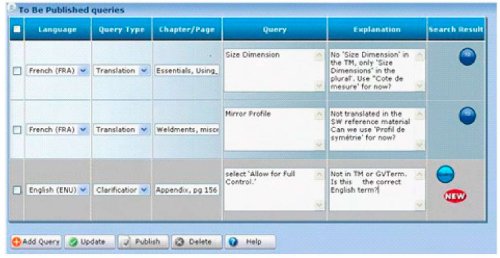How to structure and streamline the in-country proof
By Nabil Freij,
President, Founder and Owner
GlobalVision International, Inc.
Become a member of TranslationDirectory.com at just
$12 per month (paid per year)
 Imagine
the following: First, you are tasked to organize people in different countries,
operating in different time zones, with different cultures and languages,
not reporting to you, to participate in what will be a very laborious
task. Second, these people are committed to doing other jobs that take
up all their work time. Third, it is very likely that you cannot offer
them incremental pay! Those who have been involved in coordinating in-country
proof of a translation or a localization project understand how difficult
the process can be. Imagine
the following: First, you are tasked to organize people in different countries,
operating in different time zones, with different cultures and languages,
not reporting to you, to participate in what will be a very laborious
task. Second, these people are committed to doing other jobs that take
up all their work time. Third, it is very likely that you cannot offer
them incremental pay! Those who have been involved in coordinating in-country
proof of a translation or a localization project understand how difficult
the process can be.
Attending to the above is a major undertaking for even the most experienced
project manager. Are you overwhelmed already?
This is why some in our industry argue that an in-country proof is not
needed after the translation of a product is completed. We can’t disagree
more.
The case for in-country linguistic proof
 Control
Theory teaches us that a dynamic system remains unstable until it has
a negative feedback loop built into it. Control
Theory teaches us that a dynamic system remains unstable until it has
a negative feedback loop built into it.
Look at the graph on the right and think of r as the source text. The
target, or translated text, is y. G is the translator and K is the in-country
proofreader.
K will have to proofread the translations of G and offer constructive
(negative) feedback to the translator to help meet the required quality.
The translation management system is H. It is a dynamic system. For it
to be stable, it will require to properly handle input from G and K- the
translator and in-country proofreader.
Also, to ensure a stable system, collaboration among the different influencers
in the system will be needed. The more efficient and optimal the collaboration
efforts are, the more stable the system will be.
10 steps you can’t ignore
Having proven that the in-country proof is crucial, here are 10 important
steps to follow to turn this challenge into a successful endeavor.

- Choose the right individuals. The more connected you are with your
international offices the more aware you will be with your options.
Pick a person that has excellent command of the local language and your
product, and that is motivated to help. If you don’t have a choice,
still qualify them to make sure that your agendas are aligned and then
work constantly on motivating them.
- Provide your proofreaders all the information they need about the
project, the tools that they will use and the process that they will
follow. Do that before the translation starts so that they are setup
early and can ask any questions when there is time still to address
them.
- Provide necessary training for special tools or processes that they
will use to ensure that they have full control over their tasks and
follow all the appropriate steps. Unlike professional translators, your
in-country proofreaders are not expected to know how to use translation
memory (TM) tools or deal with terminology or specialized translation
file formats.
- Get your proofreaders to review the terminology in their own languages
early and approve them. Give them a chance to influence them before
the translation starts, or while it is ongoing. Giving them ownership
and ability to influence the end-quality early in the process makes
them feel part of the overall process, and not just an afterthought,
or the go to person to fix all problems in the last minute.
- Enable your proofreaders with technology to facilitate their work
and communicate with the project stakeholders. Most people like to use
MS Word to make corrections, or, annotate PDF files. Try to make the
proof process work with these simple tools. However, give them access
to an easy to use, but robust translation management system to communicate
answers to translator queries and to preview the terminology.
- Pin down the file handoff process so that translated vs. proofed files
are not confused or lost.
- Allow for your translators to see the changes that are implemented
by the proofreaders to learn any style or terminology nuances, or preferences,
and to correct any inconsistencies, typos or grammatical errors.
- Enable a process that facilitates the inclusion of the corrections
from proofreaders into the Translation Memories for future reuse. You
want to avoid asking your proofreaders to apply the same changes each
time your source changes; it will demotivate them from doing their work
in future releases.
- Allow proofreaders ample time to complete their work. Remember, they
don’t report to you and you don’t control their time or paychecks.
- Give your proofreaders positive reinforcement often throughout the
project. You can only influence them through proper motivation and leadership.
Ignore any of these steps and you are likely to suffer the consequences
during or after the project’s completion.
Streamline the process
To facilitate the linguistic proof process, it is preferable to have
multiple linguistic proof methodologies available to you to help meet
each client’s specific needs. Here are three main options:
- Table format with 2 columns, source and target. Proofreaders read
the source in the first column and make the necessary changes to the
translated text in the second column either online or in a tool like
MS Word. Translators then see exactly where the changes are made and
apply all necessary corrections.
- MS Word Document in bilingual format with source and target languages:
Here the source and target are interlaced. The first string contains
the target text and the second string contains the source text separated
by a number that shows the fuzzy match from the TM. Proofreaders can
decide to proof only new strings to the release. Changes are made in
MS Word for translators to see where the changes take place to correctly
act upon them.
- A draft PDF of the target file is provided to the proofreader where
he or she can electronically annotate the PDF with the requested linguistic
changes. The annotated PDF file is then returned to the translator to
implement the changes in the target files.
Note that a thorough linguistic proof is always a laborious process which
if not planned correctly, may cause serious delays to the project. Your
goal should be to eventually turn your translators, or translation vendor,
into your final proofreaders, after gaining experience on your end-users’
specific requirements and after following a rigid process that leverages
the latest advances in translation management which keep the translators
closely connected with the in-country product experts.
In order to reach this goal, think about integrating in your process
the following enabling technologies that will help shift the burden of
proof from the in-country proofreader to the translator:
- An online terminology portal can be populated with your terminology
in all languages and can be accessible to all translators and proofreaders
while performing their work. By communicating the correct terminology
to use, translators can be consistent and accurate in using the proper
terms from the start.
- A wiki-based portal can allow easy collaboration between the translators,
the reviewers, the project manager, you, and your proofreaders. This
environment permits translators to ask questions about the source, moderated
by project managers, and work closely with your proofreaders in order
to provide the best fit translations when the translator is in doubt.
Ensuring translators’ accurate understanding at the beginning reduces
the requirements for change at the end.
- A translation management system will host all files, source and target
to keep assets organized and to display the status of each task in each
project. As one of the above three described proof options is applied,
all terminology, translation memories, files and other pertinent translation
assets will be updated with your feedback before proceeding with the
desktop publishing or final build and release of the completed work.

Click picture to enlarge
As you build a translation memory,
active feedback from qualified proofreaders will make it a better resource
to rely upon, eventually eliminating the need for a comprehensive linguistic
in-country proof. The translators would understand your special style,
terminology and preferences for producing your documents. Style guides
will be beefed up and consistently followed. Stakeholders will also continue
to use the translation memory, the terminology database and the query
database to ensure accuracy not only within your division’s projects and
products, but throughout the entire organization. Overall, your corporate
international communications, brand and image will significantly improve.
The ideal world
While performing in-country linguistic proof may be a necessary step,
the goal is to streamline the process and minimize the amount of work
to be done while delivering the expected high quality products to your
international users.
What is the lesson to take here? Despite of what others may tell you,
don’t let translators translate in vacuum. Translation is not a task that
you can throw over the wall to others in a process that excludes in-country
input and guidance. If you do that, the translation quality will sooner
or later diverge from your requirements and your end-users will someday
give up on using your localized product.
Therefore, quality translation requires a collaborative translation management
system. One that permits information sharing, that improves terminology
understanding, that tracks schedules and tasks, that facilitates the feedback
process, and that truly allows a two-way dialog, between the translators
and product experts, to improve product quality and usability.
Next time you are told to forego your in-country proof, ask your localization
or translation vendor to consider using a robust translation management
system, or better yet, hire someone that does!
Author BIO:
Nabil Freij is the author of Enabling Globalization
and the president, founder, and owner of GlobalVision International, Inc.
(www.globalvis.com), a Localization
and Translation specialist. He is trilingual and holds an MSEE from Brown
University and an MBA from Bryant University. Freij’s blog can be read
at: http://blog.globalvis.com.
Published - June 2012
Submit your article!
Read more articles - free!
Read sense of life articles!
E-mail
this article to your colleague!
Need
more translation jobs? Click here!
Translation
agencies are welcome to register here - Free!
Freelance
translators are welcome to register here - Free!
|


